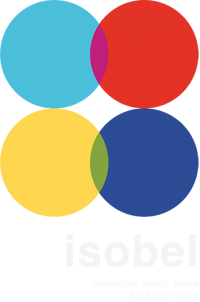Sound plays a significant role in health and well-being. Unwanted sound is a stress inducer, causes cardiovascular complications, and reduces productivity. On the other hand, wanted sound, i.e. music and ambient sounds, has healing effects, induces feelings of happiness, and can relieve stress, pain, and anxiety.
The Danish companies Bang & Olufsen, SoundFocus and Wavecare have joined forces with two departments from Aalborg University (Department of Electronic Systems/Department of Computer Science) in order to develop and test an interactive and dynamic sound zone system.
Meeting the aim, the project will:
- Develop new signal processing technology for making sound zones dynamic.
- Develop new interaction techniques enabling user control of dynamic sound zones.
- Test interactive dynamic sound zones in real healthcare and domestic settings.
The need
The project addresses the need for control of wanted and unwanted sound, which we are all exposed to in several contexts, including in healthcare settings, private homes, the workplace, and in public.
But sound control is not merely a matter of shielding people from noise. It is a matter of reducing unwanted sound while providing wanted.
Sound control has several domains of intervention, in particular, the healthcare sector and private homes. In healthcare settings, sound control can lead to improved curative care and reduced hospital time. Here, sound zones will reduce unwanted sound, for example, noise from other people, equipment, etc., while at the same time delivering positive music interventions. It also enables much-needed sound exposure control for staff [1].
In private homes, research shows that people live with sound in many ways and that music is a prevalent part of everyday life. However, homes with large living spaces do not allow different sound sources to coexist well for people with different preferences and needs. This leads to mental stress and unpleasant experiences caused by multiple overlapping devices in the same living space. Here, sound zones will support well-being and preventative care.
Sound zones will allow better social coexistence in everyday life and create sonically coherent spaces [2], as well as positive sound experiences for the individual. They will also cater for a need and desire to have flexible, distributed sound in people’s living spaces identified by B&O [3].
The solution offered by ISOBEL aims to make sound zones work in the real world through adaptive signal processing based on real-time feedback measures of actual system performance on key factors. This allows sound zone systems to respond to changing conditions of the environment, respond to user input, and change their properties without physically moving equipment.
Did you know?
- WHO reports that noise causes severe harm and a loss of more than 1 million life-years in Europe annually [4].
- Noise can lead to cardiovascular complications [5, 6] and increased risk of heart attack [7, 8].
- Noise can induce psychological effects such as annoyance, psychiatric disorders, personality changes, and reduce psychosocial well-being [9-12].
- Stress from noise is linked to aggression and antisocial behaviors, insomnia, and lack of well-being at home [13].
- During the night, 20 percent of Europeans are exposed to sound levels, potentially damaging their health.
Contrasting this…
…Wanted sound, like music, offers well-documented benefits for both health and quality of life [14]. This includes somatic disorders [15-17], psychiatric disorders like depression [18], and also significant people’s general well-being from, for example, cognitive enhancement, stress reduction, and better sleep [19-21].


